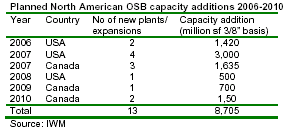| Home: Global Wood | Industry News & Markets |
¡¡
¡¡
| Home: Global Wood | Industry News & Markets |
|
North
American Lumber Market | ||||||||||||||||||||||||||||||
|
US companies get disbursements of import duties In 2005, the US government collected anti-dumping duties on Chinese wooden bedroom furniture imports ranging from 0.83% to 198.08%. Under the US law, the anti-dumping duties must be disbursed to companies harmed by the Chinese imports. The US Customs and Border Protection Agency has now paid to 24 US furniture manufacturing companies (all petitioners of the 2004 dumping investigation) a first instalment amounting to a total of $144,159. The disbursements ranged from $627 to $28,713, with Stanley Furniture receiving the highest amount. These payments represent only a small fraction of the total duties levied by the US government in 2005. More disbursements have been announced. US housing market continues to slow The US housing market continues to slow. The pace of construction of new houses slipped 7.4% in April, according to the US Census Bureau. Confidence in the housing industry is at its lowest ebb since 1995, according to the National Association of Home Builders. Former US Federal Reserve Chairman, Alan Greenspan, said that the house boom was over and predicted that there was no danger of a total collapse of the housing market. He added that Americans¡¯' consumption could taper off somewhat now that the US housing market¡¯s ¡°extraordinary boom¡± had ended. OSB capacity expands amid soft price forecast Contrary to the lacklustre MDF and plywood markets, OSB continues to be a hot product in North America, according to International Wood Markets (IWM). OSB producers benefited from the stellar North American housing demand, a high-cost competing product (plywood) and an ongoing shortage in panel supply. Strong demand and short supply led to record high prices for OSB. Since mid-2003, OSB prices have exceeded $250 per msf (thousand square feet), peaking at over $500 in April 2004 and trading between $250 and $390 since then. In contrast, between 1996 and mid-1998 and for most of 2001 and 2002, OSB prices rarely went over $200 per msf. In conjunction with the rising prices, OSB mills enjoy exceptionally high earnings and very liquid cash positions. On average for the last three years, the dominant producers¡¯ financial statements show earnings before interest, tax and depreciation allowance (EBITAD) of approximately $120 per msf, representing an EBITAD margin on sales of about 35%. This constitutes a payback period of less than three years on a modern mill. To grow business further, most of the leading OSB players have announced new greenfield plants or expansions of existing plants. Growth by way of acquisitions is less feasible. The few firms that could potentially be for sale have a very high ¡°sticker¡± price. Already in 2005, two new mills (Canfor/L-P and Georgia Pacific) were built, plus a few smaller expansions, for a total increase in capacity of almost 1.5 billion sf. Two more mills (Norbord and Marco) will start-up later in 2006 while seven new plants will add a whopping 4.6 billion sf of OSB supply in 2007. IWM forecasts that the total capacity expansion between 2006 and 2010 may be as high as 8.7 billion sf. 
| ||||||||||||||||||||||||||||||
|
Abbreviations
| ||||||||||||||||||||||||||||||
|
Source: ITTO' Tropical Timber Market Report |
CopyRight 2006 Global Wood Trade Network. All
rights reserved
¡¡